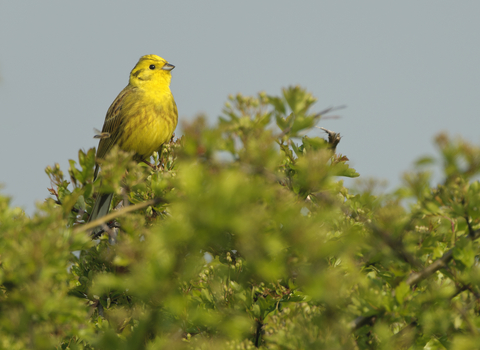Why manage hedgerows?
Our hedgerows support an amazing diversity of plants and animals, providing wildlife with a rich larder throughout the year: bees and other pollinators buzz around their flowers in spring, turtle doves purr from their depths in summer and redwings pluck berries from their branches in autumn and winter.
As well as providing food and shelter, hedgerows create vital links across the countryside, helping wildlife to move freely about and keeping populations healthy. They're also good for the landscape and the wider environment, preventing soil erosion, capturing pollutants such as fertilisers and pesticides running off fields, assisting with water regulation, storing carbon to help combat climate change, and providing homes for predators of many pest species, as well as sheltering livestock.
But lack of management, or the wrong kind of management, can lead to them losing much of their value for wildlife.
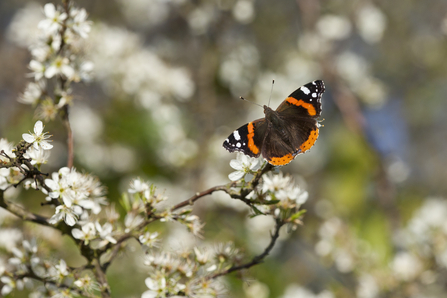
Red admiral on blackthorn blossom ©Guy Edwardes/2020VISION
Where do we start?
Surveys
Before you begin any management work on a hedgerow, assess what plants and animals are currently growing and living within it. This will help you work out what management might be best across your site, while avoiding disturbance to rare or protected species. Some trees within a hedgerow might be hundreds of years old, while hedgerows not cut back annually might provide important feeding corridors for bats such as lesser horseshoes.
Who can help you do this?
There are likely to be skills and local knowledge within nearby wildlife groups, and individual naturalists and ecologists. You could also upskill yourself and/or your team by going on identification courses offered by Wildlife Trusts or other organisations.
What species are protected?
Some animals, such as hazel dormice and all bat species, need a licensed person to check nest boxes and nearby roosts for their presence. These animals depend on this protection from disturbance and habitat changes. If you’re unsure, contact Natural England.
Birds nest between March and September so avoid any cutting or changes to the hedgerow during this period. Many species, ranging from dunnocks to linnets, will still be laying eggs in August, and perhaps early September.
Looking up historical and habitat information about your hedgerow may give clues as to how it has been previously managed or laid out, helping you to plan what to do next. Your local Wildlife Trust can give professional advice if needed.
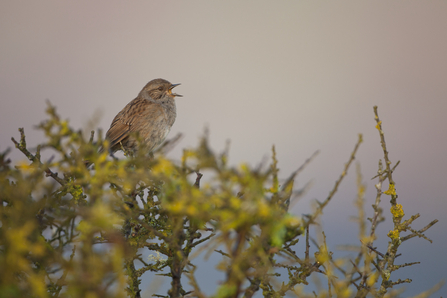
Dunnock singing from a hedge ©Mark Hamblin/2020VISION
Maintaining established hedges
When to trim
No cutting should take place during peak bird nesting season, which runs from March to September. Where possible, delay any maintenance work until January or February, as hedgerow berries provide a valuable autumn and winter food source for birds like redwings, blackbirds and fieldfares.
Hedges should not be cut every year, as flower buds often form on second-year growth. Trimming hedges on a two or three year rotation, targeting different sections each year, will make sure there are always flowers for pollinators in spring and berries for birds in autumn. Hedges cut every three years can produce two and a half times as much blossom as those cut annually. Rotational cutting can also save time and money that would be invested in annual cutting.
If the hedge network is extensive, a flail may be the most efficient way to cut. However, a circular saw creates a cleaner cut, which encourages better re-growth and is less likely to encourage disease. If using a flail, ensure the flail is kept sharp for an effective cut.
Shape and size
Hedges come in different shapes and sizes, and the type of hedgerow will influence the wildlife that it most benefits. Providing a diverse selection of hedgerow types will offer food and shelter to a greater range of wildlife.
Hedges are often trimmed to an ‘A’ shape, which is thicker at the base and gets narrower at the top. This provides maximum protection for wildlife, while allowing light to reach the ground flora. Some birds, such as yellowhammers, grey partridges and linnets, prefer short hedges (under 2 metres), with a thick base and wide grass buffer strips. Other species, including song thrushes, bullfinches and turtle doves favour taller hedges (over 4 metres).
Buffer strips are important for most species. By providing at least two metres of uncut grass next to the hedge, you’ll be providing ideal nesting, feeding, egg-laying and overwintering habitat for birds, insects and small mammals.
Where possible, allow trees to develop at roughly 20 metre intervals; these can be used by birds as song perches as well as creating more habitat for wildlife. Ash, field maple and hornbeam are especially good and oak is home to a huge number of insects. Mature and dying trees should be retained where they are not a hazard, as they are important for insects, bat roosts and hole-nesting birds.
Climbers can be introduced to add extra thickness and interest. Try adding honeysuckle, ivy, old man’s beard, and white and black bryony to provide extra shelter and nesting space.
Coppicing
This is a traditional management technique that involves cutting a tree in order to encourage enhanced growth. This can rejuvenate a tree and allow it to last for many years.
Coppicing may be needed to grow a thicker hedge and involves cutting down to just above ground level to encourage vigorous regrowth. Coppicing is best done in winter and performed in sections to reduce any disturbances to wildlife. Cut at an angle to allow the water to run off, and in the spring several shoots will grow up to create an overall bigger hedge. Young shoots may be grazed by deer or rabbits, so it may be worth protecting them with mesh or brash (cut branches) until fully established.
To thicken hedges even more, cut shoots again at the end of the second winter, making the cut at about 45cm from the base of the shoot to create a second spring regrowth.
Elm hedges
Your hedgerow may contain young elms. While many mature elm trees have died as a result of Dutch elm disease, if elm hedges are coppiced in sections on a 15- to 20-year rotation, the growth of vigorous suckers will occur and the disease can be avoided. The disease is carried by the elm bark beetle which burrows beneath the bark of trees which are 10 or more years old.
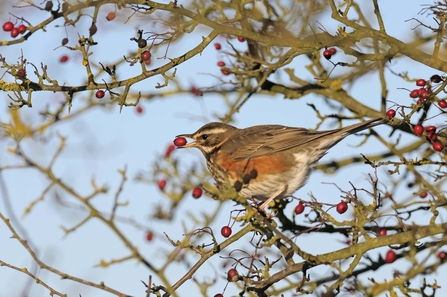
Redwing feeding on hawthorn berries ©Chris Gomersall/2020VISION
Planting new hedgerows or filling gaps
Creating new hedgerows is a great way of helping wildlife. You might be planting a brand new hedge, replacing one that was removed in the past or filling in gaps where trees have died. Below are some tips on how to plant a new hedgerow.
When?
November–March. Trees aren’t busy losing their leaves or producing buds, so they can be moved without causing harm. Avoid planting in very cold or windy weather to reduce the risk of damage to the new roots, and never plant in waterlogged or frozen soil.
How?
-
Select the species mix: approximately 70% of the mix should comprise hazel Coryllus avellana, hawthorn Crataegus monogyna and blackthorn Prunus spinosa. Ideally half of the total mix should be a mix of the 2 thorn species. Outside of this, look to plant additional native species, local to the area. A good quality hedge will have at least 5 species in total, though more is better.
- Prepare the site – remove all weeds and roots and mix in plenty of manure and organic matter to provide the new hedge with lots of food (this will also prevent soils becoming waterlogged in winter and save you needing to water the hedge so much in summer).
- Mark out two parallel lines with string, about 20cm (8 inches) apart, along the line of your new hedgerow.
- Clear any grass and vegetation between the two lines of string.
- Use 40cm (16 inch) lengths of cane to mark out the distances between the trees and shrubs, creating a zigzag pattern. It is advisable to plant five plants per metre for a thick hedge, at 40cm intervals. If you are planting as part of an agri-environment scheme, you will probably need to plant 6 plants per metre, in which case use 33cm (13 inch) spacing.
- Dig a hole or a trench for each plant, and place the plant in the hole ensuring the roots hang straight. It should be planted to the same depth as it was in the nursery (look out for the root collar). Mix plants up as much as possible so that the hedge all grows at a similar rate.
- Water well!
- A mulch of chopped bark placed along the edge of your new hedgerow will lessen the number of weeds and reduce moisture loss.
Then what?
In the first spring, the shrubs should be cut down to 45–60cm above the ground to encourage them to ‘bush out’, creating a nice thick hedge. During the first summer, weed around the base of the shrubs to prevent competition, while watering regularly. In late summer, some trees and shrubs may have died; replace them with new ones in autumn/winter to prevent gaps forming.
Choosing and buying
A good hedgerow consists of a wild mixture of different trees and shrubs; the best examples of these are the oldest. Always stick to native trees and shrubs, as these will provide the best flowers and berries for local insects and birds. Check any local hedgerows to see what grows near you so this can be reflected. Hedgerow plants will normally be sold as bare rooted whips (small plants up to 80cm), which establish better than large plants, provided the roots do not dry out. The roots are very delicate and so are sensitive to wind, frost, sun and snow. Therefore it’s best to keep the whips in thick hessian sacks (watering them regularly) right up until they are planted.
Hawthorn, blackthorn and hazel are good for making a thick hedge – but a selection can be added to diversify the habitat, including field maple, holly, wild privet, dog rose and buckthorn. However, a mixed native hedge can be created using just three species – where possible try to include three plants of the same species per metre with one each of two other species.
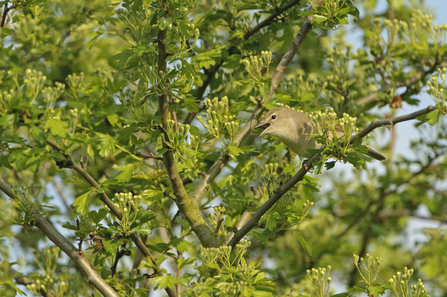
Garden warbler singing in a hawthorn hedge ©Chris Gomersall/2020VISION
Further information
- Hedgelink, working together for the UK’s hedgerows
- Natural England/UK Government. BE3: Management of hedgerows. Eligibility and requirements for the management of hedgerows option
- Centre for Ecology & Hydrology. Hedgerow management and rejuvenation: understanding how to improve hedgerows for wildlife
- MacLean, M. 2006. Hedges and Hedgelaying: A Guide to Planting, Management and Conservation. The Crowood Press Ltd, Marlborough, Wiltshire.
- Wright, J. 2016. A Natural History of the Hedgerow: And Ditches, Dykes and Dry Stone Walls. Profile Books, London.
A home for wildlife
Hedgerows are often a mix of shrub and tree species such as hawthorn, blackthorn, hazel, ash and oak, interwoven with climbers like old man’s beard and honeysuckle. Banks and ditches fill with flowers like hedge bedstraw and red campion. They in turn provide important homes for wildlife such as:

